If you haven’t been outside recently and have somehow avoided all media for the past month or two, it appears that there is a worldwide event going down right now, something that people are taking pretty seriously. For some in rural towns, global events have a way of passing by as they soldier on, living pretty much the way they always have. But for the rest of us it’s hard to be unaffected by current events taking the world by storm.
Whether it be the ridiculous popularity of TikTok (or as I like to call it, Vine 2.0) or a seriously dangerous epidemic, most of the connected world will be very aware of the next thing that goes viral.
We are living in an ever more global society where the other side of the world is just a phone call or a flight away. Ever since intercontinental flight became routine, and trains, buses, or cars have helped people travel great distances in short amounts of time, the regularity and demarcation of time and their associated zones has become essential in helping the world to run smoothly.
In the early days of horology, aside from accurate navigation at sea and precise scientific measurements, there wasn’t much need for most to know the exact time, let alone across great distances. For a long time, if you happened to have a watch or clock, you would simply set it to the local time and go about your day.
It took the widespread use of trains to push countries to adopt some standardized time zones, beginning in the mid-1800s, and a global time zone standard wasn’t adopted by every country until the last holdout, Nepal, implemented UTC+5:45 in 1956.
During the adoption of time zone standards, the earliest pocket watches with indications of global time became obsolete as a more regular system was put in place. The first modern iteration of the world time complication was developed by Louis Cottier and found its way into a pocket watch for Vacheron Constantin in 1932. Five years later, the pivotal step to put it in a wristwatch was taken by – who else? – Patek Philippe.
The history of the world time complication is intimately connected to Patek Philippe, and due to its pedigree is often considered to offer the ultimate in world time watches.
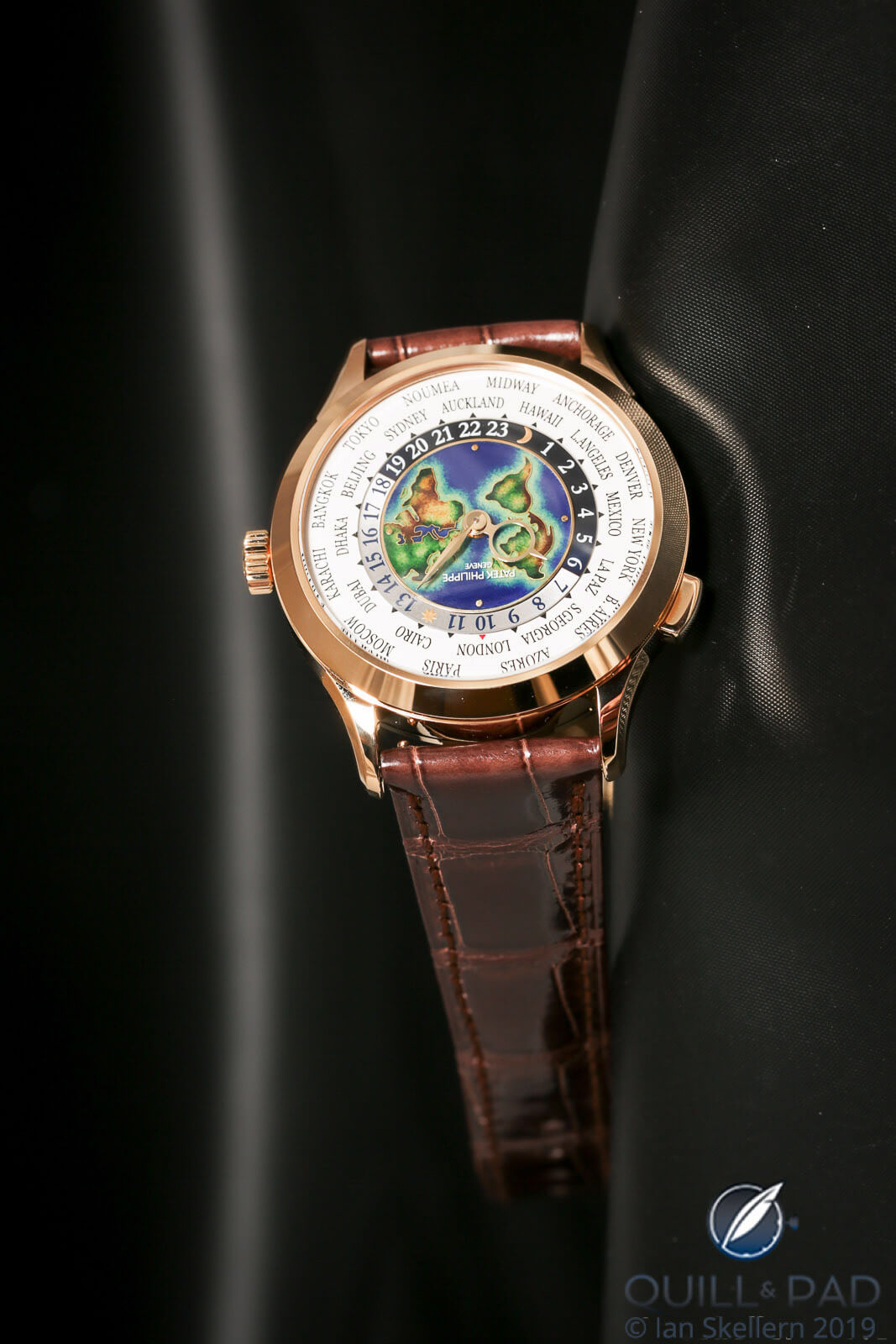
Patek Philippe Reference 5231J World Time
It’s hard to argue: the first on the scene will always be synonymous with an entire category. That is why the modern iterations are so popular. And when Patek Philippe introduced the 5231J World Timer at Baselworld in 2019, many applauded the continuation of the tradition since it’s a perennial favorite.
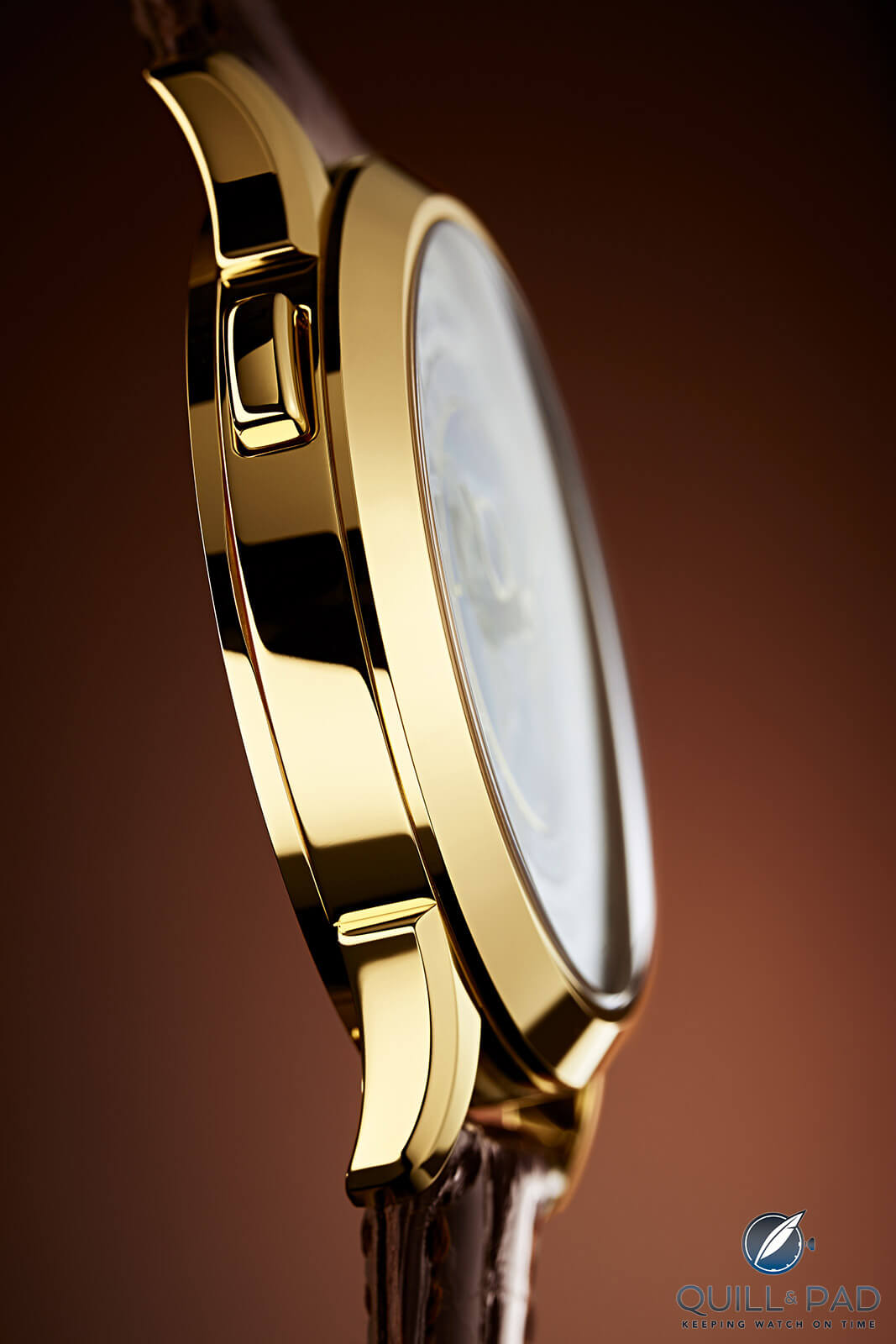
The Patek Philippe Reference 5231J World Time cuts a trim profile
Patek Philippe Reference 5231J World Time
Like the models released over the last decade, the 5231J follows a similar aesthetic overall but, like the other 52xx World Time watches, it departs from the Calatrava-style smooth case and goes with a chiseled lug style and much more geometric shape.
Previously, all of the World Time watches sporting cloisonné enamel dials – the Reference 51xx models – have sported a most classical look and even had no branding on the dials of the watch, akin to the original pieces from the 1930s.
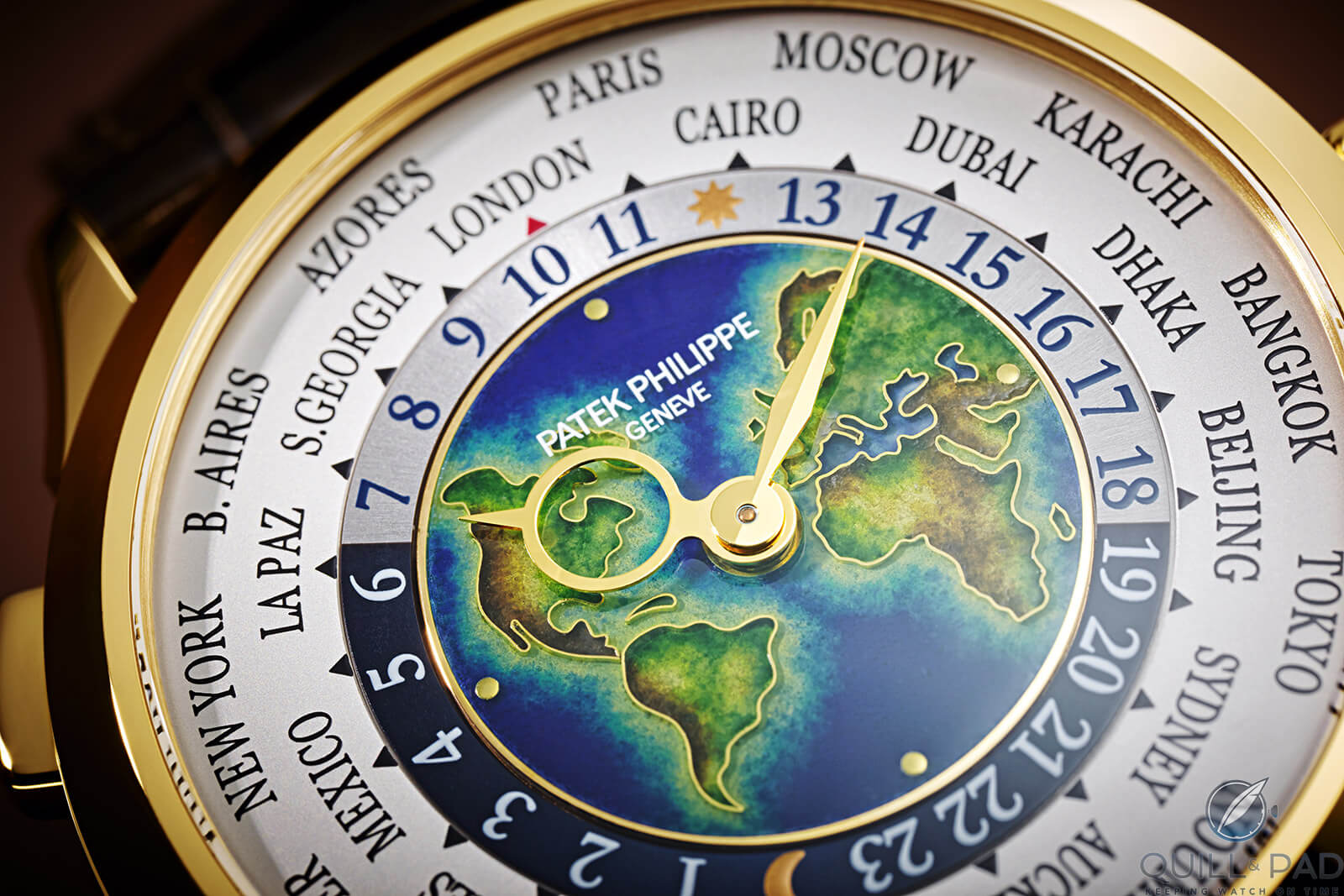
Dial of the Patek Philippe Reference 5231J World Time
Instead, the Patek Philippe logo and the word “Geneve” were engraved onto the bezel at 12 and 6 o’clock. The new 5231J and other 52xx models adopted the more standard “Patek Philippe Geneve” logo just below 12 o’clock, updating the aesthetic to match the majority of the brand’s timepieces.
But most of the well-known World Time aesthetic is still there. Encircling the outside of the dial the city disk displays 24 cities corresponding to the 24 different time zones, though it isn’t a complete world time display as it does not contain the half-hour and quarter-hour zones, only the main hour zones.
Moving inward, a second disk displays the 24-hour day/night time, which rotates continuously and can be set as home time or GMT indication. At noon and midnight, it features sun and moon 12 hours apart, with Arabic numerals for the remaining hour markers. The silver portion denotes daylight hours, while the dark blue is for the night. This highlights where on the earth is experiencing sunrises and sunsets and who is likely to be sleeping so that you don’t accidentally call at 4:00 in the morning.
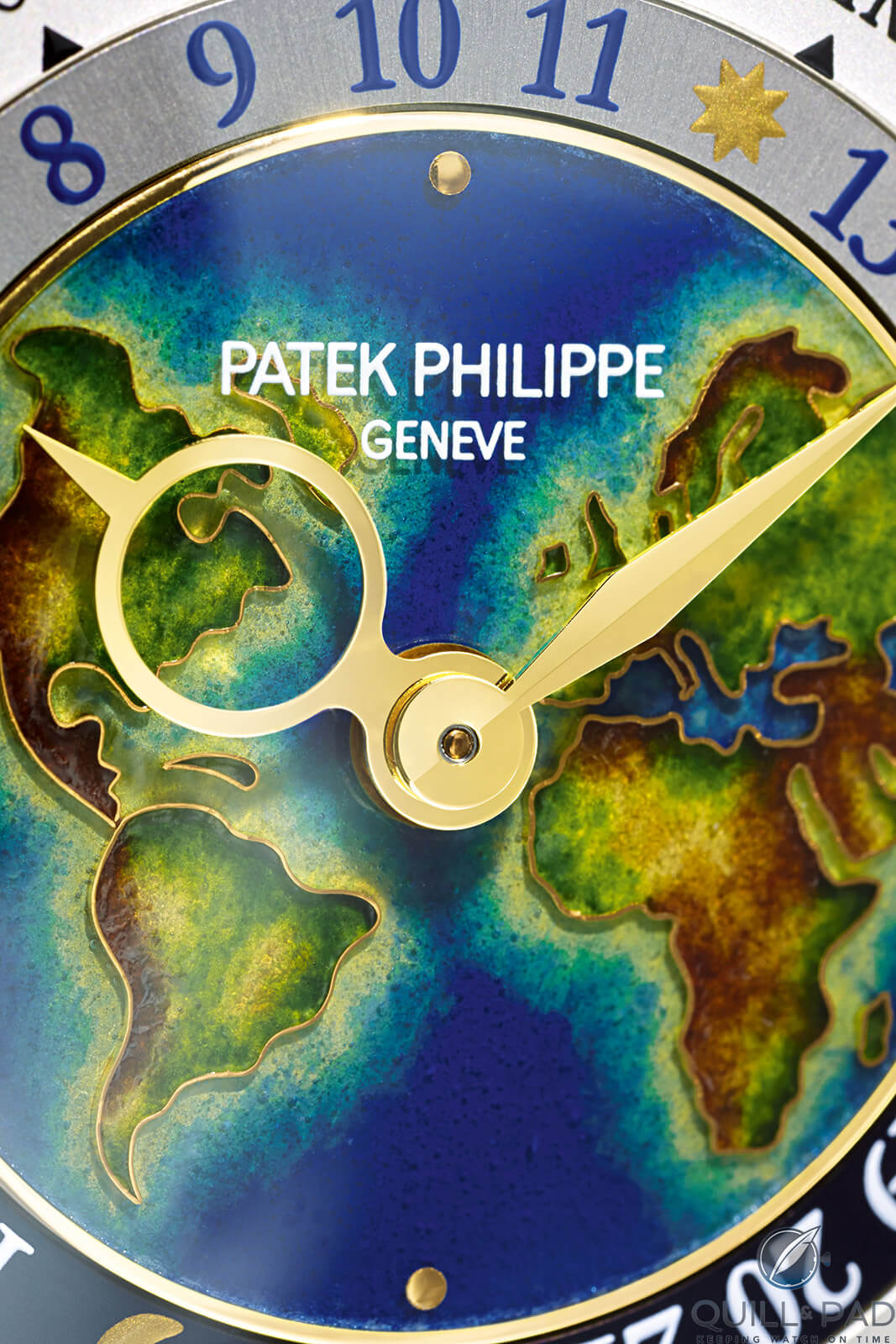
Cloisonné enamel world map on the dial of the Patek Philippe Reference 5231J World Time
In the center is the beautiful cloisonné enamel dial, specifically centered on the Atlantic Ocean and displaying North and South America, Africa, Europe, and western Asia. Embedded in the dial are four tiny gold paillons representing the four cardinal directions.
The hour and minute hands display the wearer’s local time, and to reduce any interference with the cloisonné enamel or proper reading of the time the hour hand has a large oculus in place of the lozenge style that would normally make up its body.
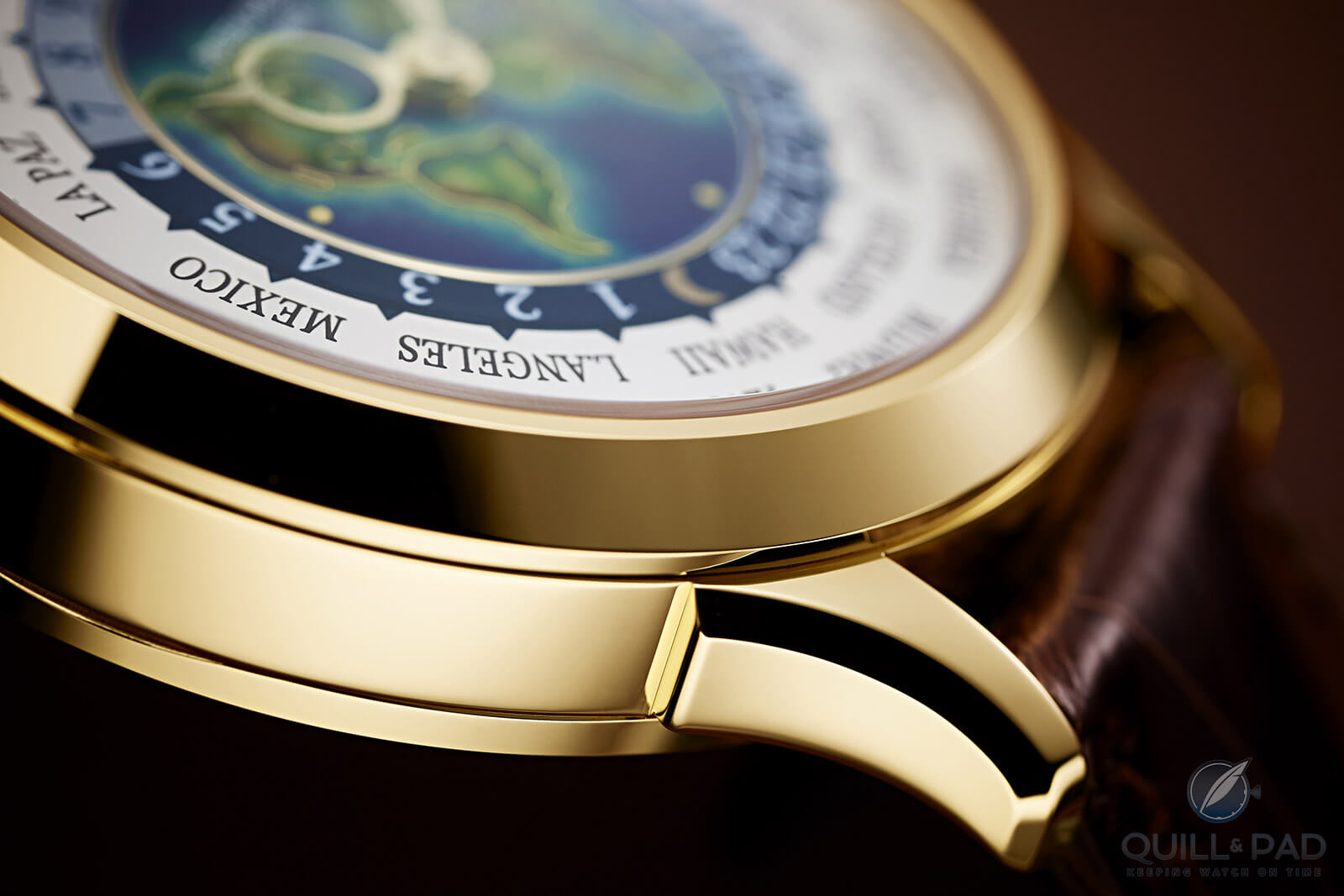
A chiseled lug on the Patek Philippe Reference 5231J World Time
Something old and something new
From a distance, the new 5231J seems to be very similar to its predecessors, but each model had cloisonné enamel dials that focused on different parts of the world. The 5131J in 2008 began with a focus that is the same as the new 5231J, but the follow-up version centered on Asia and completely cut out the western hemisphere.
The model after that continued east and centered on the Pacific Ocean to cut out Europe and Africa to only show Eastern Asia, Australia, and North and South America.
Then the 5131/1P released in 2017 switched it all up and centered on the north pole and only showed the northern hemisphere radiating out from the center, adding a large snow-covered area to match the platinum case.
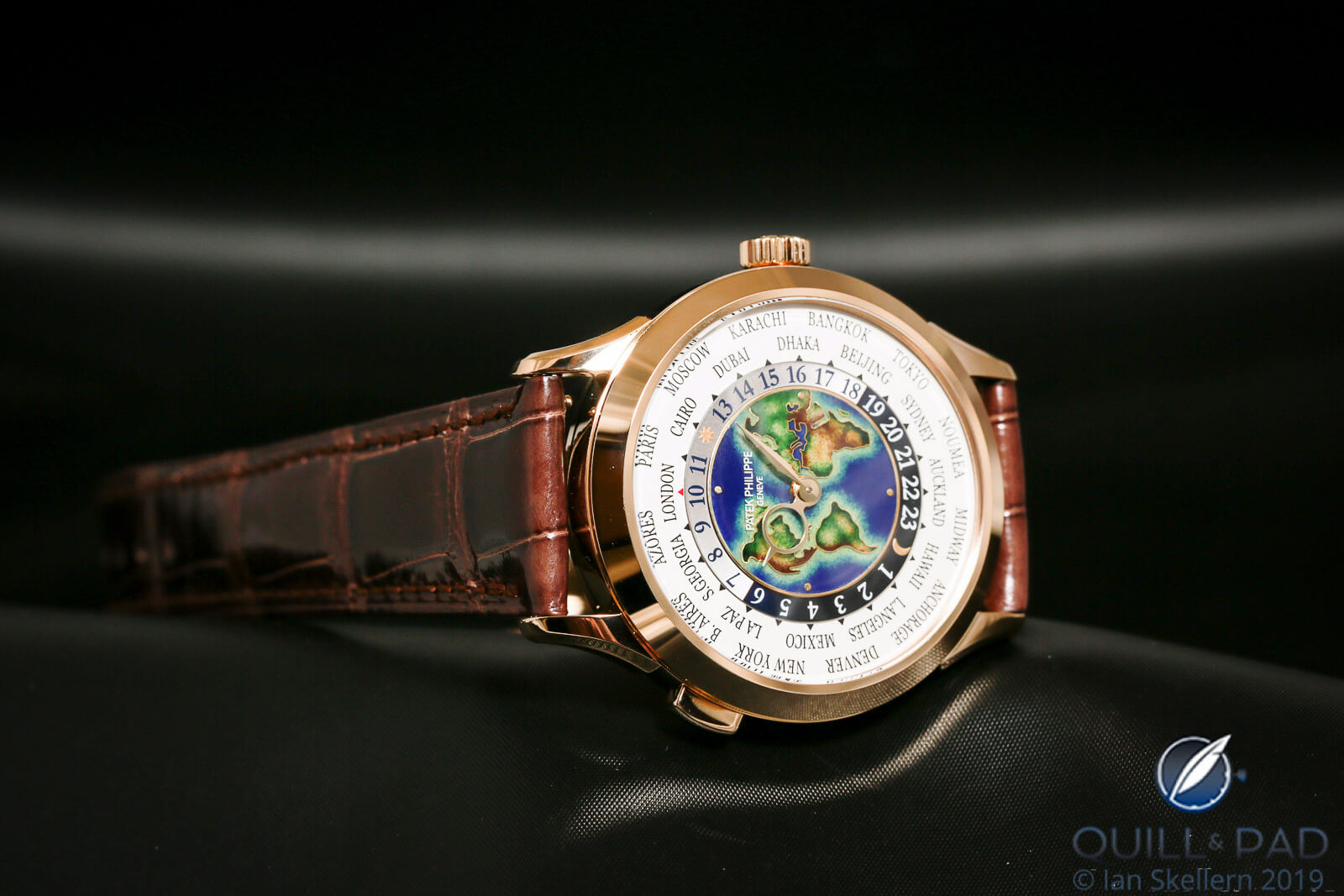
Patek Philippe Reference 5231J World Time
And now the 5231J brings it back to where it began, but not without adding a bit of intricate detail to the continents and a more nuanced color pallet for the enamel. The choice of font for the 24-hour disk and the city disk also has changed from previous models, opting for a consistent serif font across both indications.
This departs from older models that offered a script-style typography for the city disk and an unrelated san serif font for the 24-hour disk, adding a bit of discordance on the dials. The 5231J fixes that for a more cohesive dial.
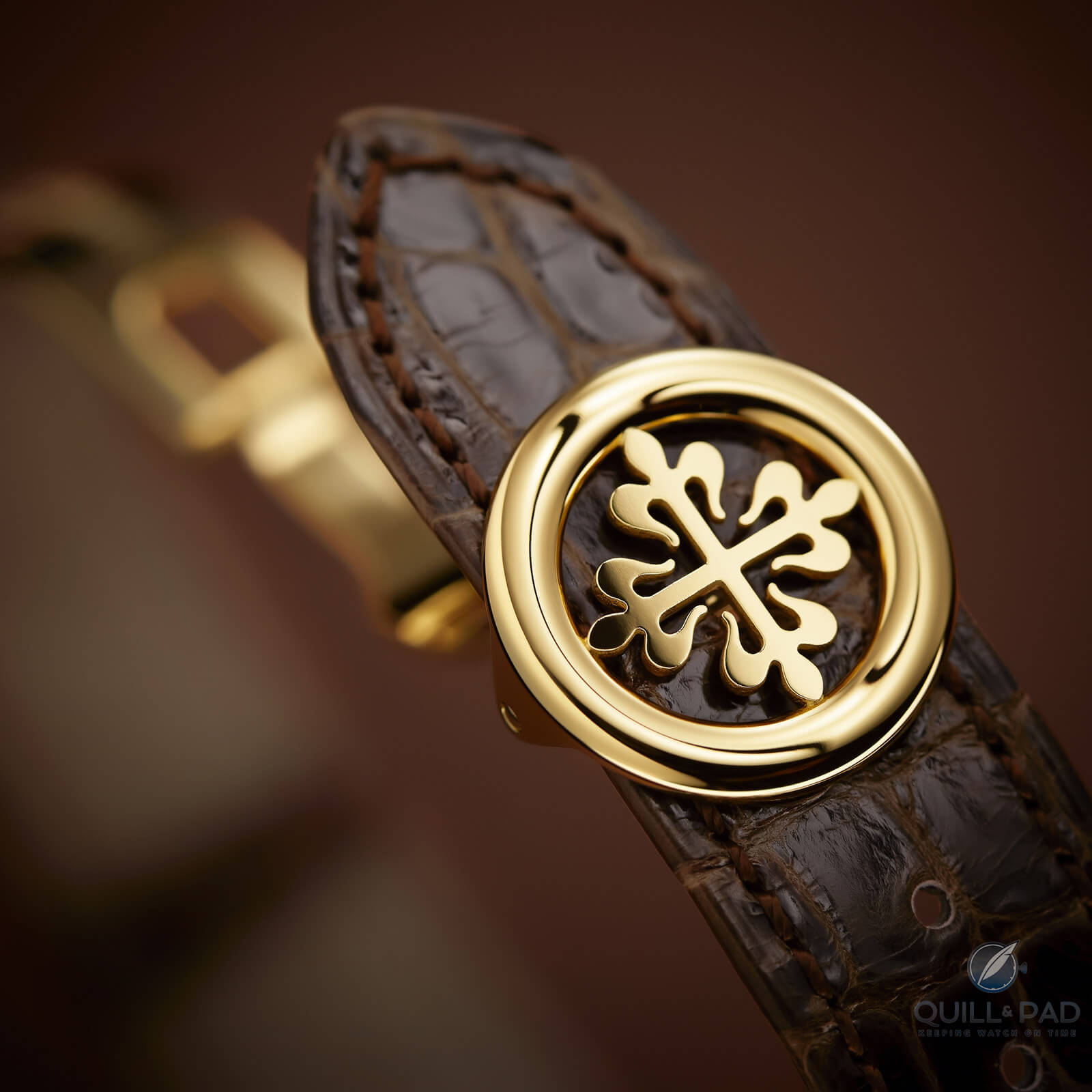
Gold buckle of the Patek Philippe Reference 5231J World Time
Interestingly, over the modern history of these models, the city disk has reflected some odd changes that demonstrate both political and economic attitudes as well as weird developments in history.
On the earliest model from 2008, the city of Caracas, Venezuela was listed but on the third version from 2015 it had been changed to La Paz, Bolivia, in all likelihood due to the fact that in 2007 Venezuela suddenly changed its time zone to UTC -4:30 on the order of President Hugo Chávez, and this watch does not show half hours. (The next president, Nicolás Maduro, changed it back in 2016.)
In 2011, Moscow had voted to switch to permanent Daylight Savings Time, putting the country at UTC+4, changing its position on worldtimer dials, and requiring this watch model to lose Dubai and instead add Riyadh on the third model.
But by the fourth iteration in 2017 Moscow had overturned its position on permanent DST and moved back to UTC+3, which brought Dubai back to the dial and restored the order.
And, finally, on the newest 5231J version from 2019, Hong Kong, a staple of international business in Asia for decades, has been dropped in favor of Beijing, the new assertive political capital of China, the new titan of the modern world and not just an ancient city.
It is also likely that Patek Philippe has been doing well within China since the country has relaxed its internal economic policies to encourage a type of limited free-market capitalism on the mainland. This is a smart move from a sales perspective, but I feel it may be a bit too accepting of the politics that run just underneath the surface. But that is a discussion for another day.
The 5231J is on the surface a simple continuation of a model line, but it is a solid update to the design language across the collection and the retirement of styles that felt a bit dated even a decade ago.
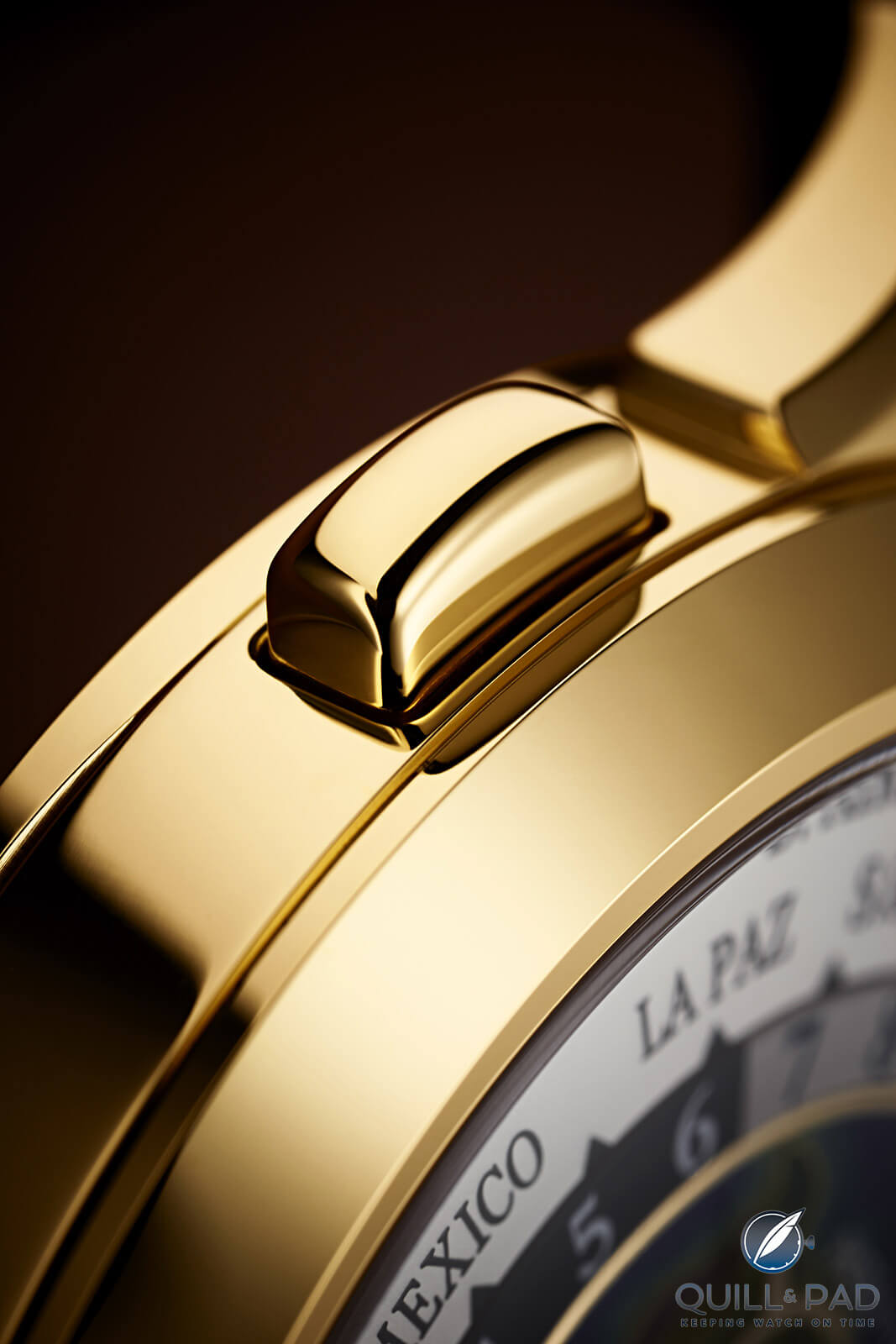
Time zone-adjusting pusher on the case band of the Patek Philippe Ref. 5231J World Time
The proportions had pretty much stayed the same but with the new case and little improvements throughout, it feels more like a modern reissue of a 30-year-old watch than an update two seasons later.
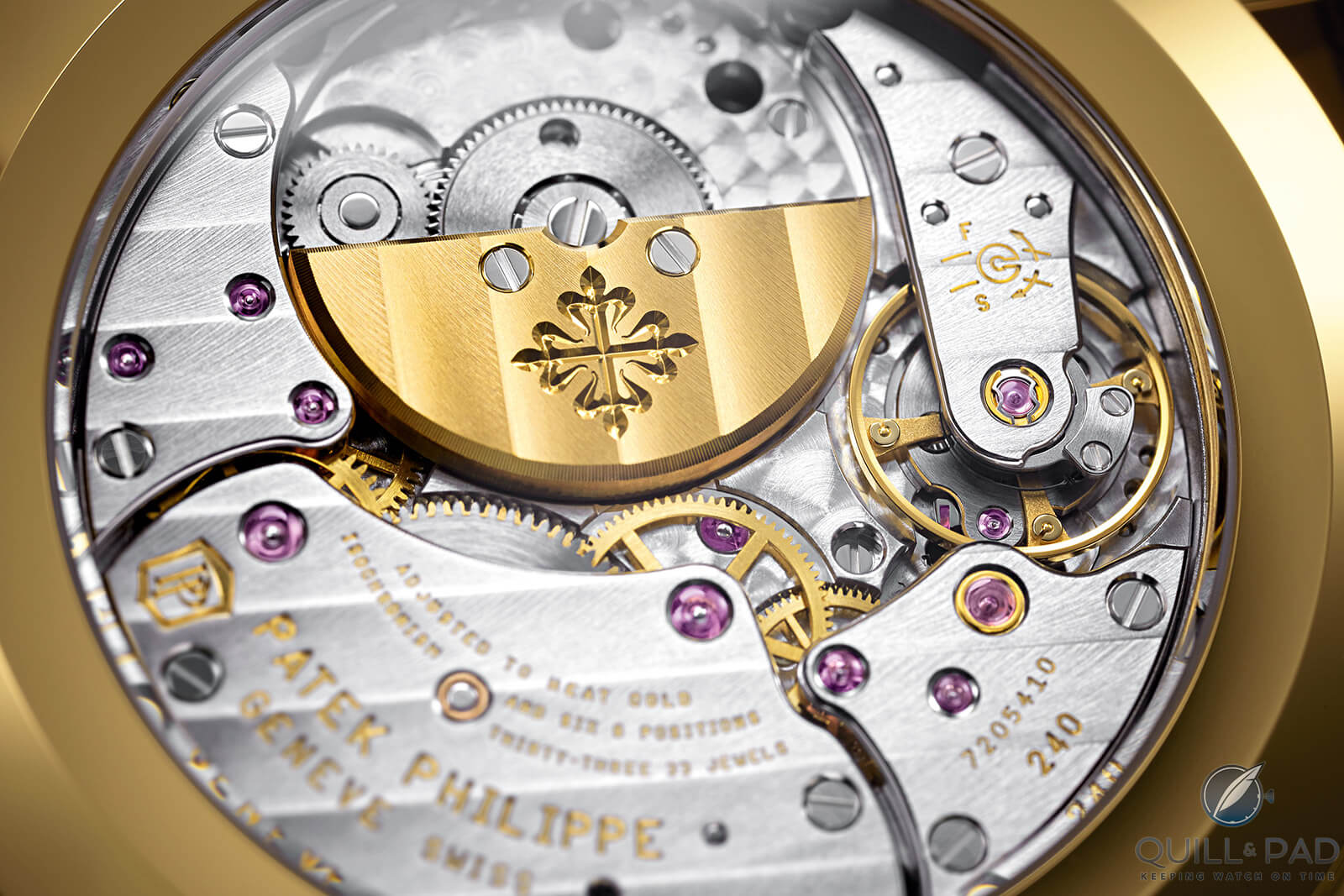
Patek Philippe Caliber 240 HU with micro rotor
It helps that it has kept the same movement, the automatic 240 HU with micro rotor and 48-hour power reserve. With that consistency to build around, the designers could really focus on honing an already sharp instrument, giving it an added boost that is very welcome for a brand that very much tries to respect its own traditions.
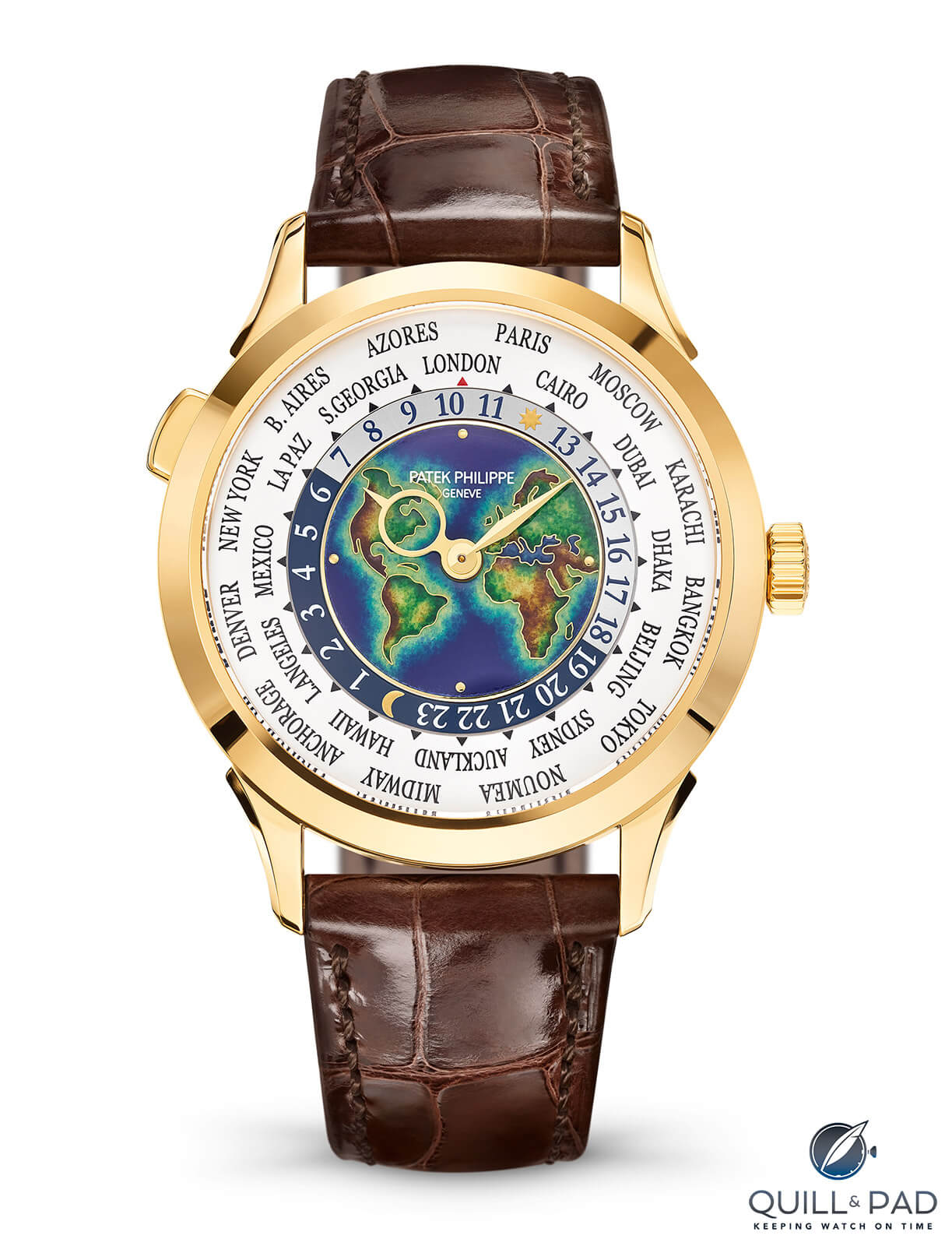
Patek Philippe Reference 5231J World Time
It seems that it is still the quintessential world time watch and can rest assured that its legacy is going strong.
Breaker, breaker, I’m gonna have to break it down here in just a few moments, copy that?
- Wowza Factor * 8.5 Icons of a category are always good for a solid wowza when a new model comes out!
- Late Night Lust Appeal * 85.1» 834.546m/s2 Enough lust to keep you up on a 21-hour flight around the world!
- M.G.R. * 57.2 Terrifically solid movement built to better-than-Geneva standards is a great core for the 5231J World Time!
- Added-Functionitis * Mild With the 24-hour and city disks it provides a little more than the basics, but not a ton. I’d recommend children’s strength Gotta-HAVE-That cream for the travelicious swelling!
- Ouch Outline * 9.89 Ripping your fingers apart after accidentally super gluing them together! If you didn’t press too firmly and there wasn’t any other material that got stuck in between, this can be solved without major surgery, but it’ll still hurt something fierce!
- Mermaid Moment * By the time you land on your first trip! Sometimes all it takes is using something how it was intended to see the true beauty and purpose inside!
- Awesome Total * 685 Multiply the case diameter (38.5) by the number of time zones the dial can display (28) then subtract the number of components in the movement (239) for a meaningfully calm awesome total!
For more information, please visit www.patek.com/en/collection/complications/5231J-001.
Quick Facts Patek Philippe 5231J World Time
Case: 38.5 x 10.23 mm, yellow gold
Dial: cloisonné enamel dial on an 18-karat gold dial blank
Movement: automatic Caliber 240 HU with micro rotor, 21,600 vph/3Hz frequency, 48-hour power reserve, Patek Philippe Seal
Functions: hours, minutes; second time zone/24-hour display, day/night indication, 24 time zone display
Price: €66,320 / $73,710 / CHF 65,000
You may also enjoy:
Worldtimer vs. GMT: Jaeger-LeCoultre Polaris Chronograph WT vs. IWC Pilot’s Watch Timezoner Spitfire
A History Of Vacheron Constantin’s Overseas Line, Culminating In 2016’s Worldtimer





















































Leave a Reply
Want to join the discussion?Feel free to contribute!